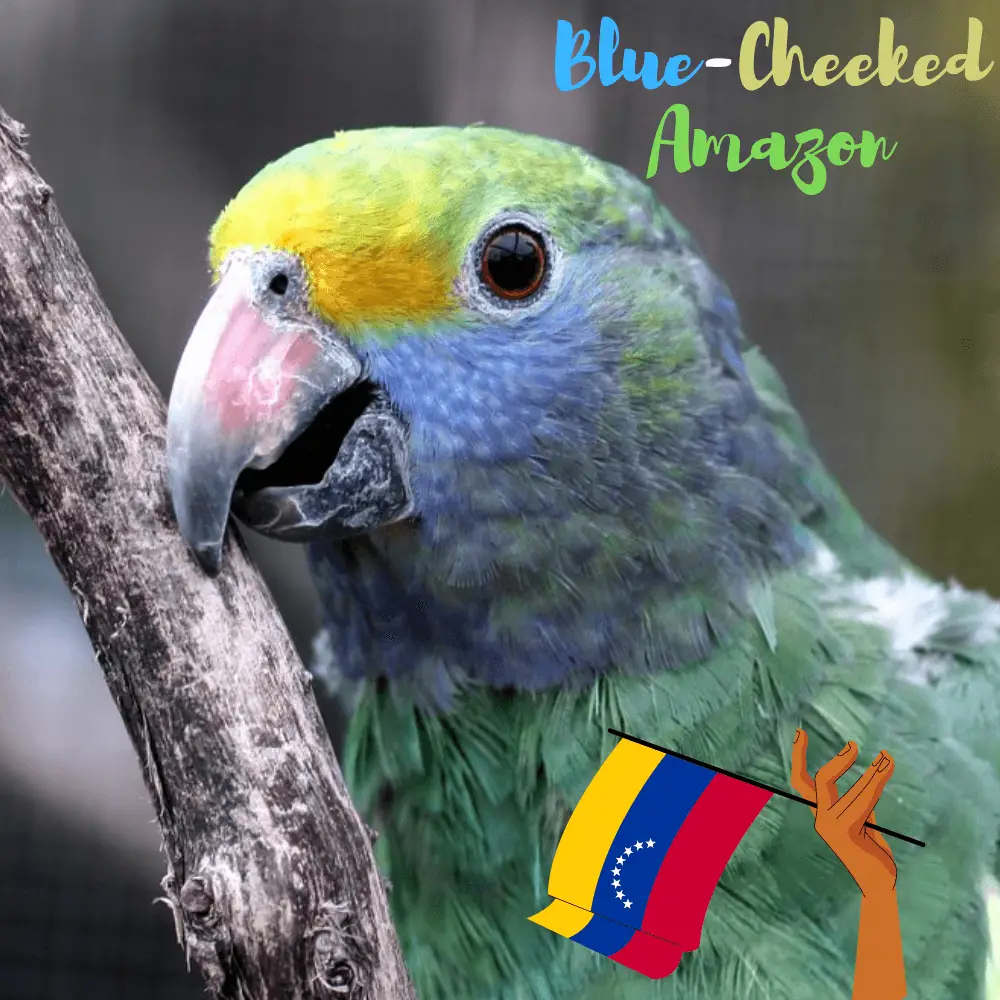
The Dufresne’s Amazon or Blue-cheeked amazon also known as a blue-cheeked parrot (Amazona dufresniana) is a fairly rare species of the genus Amazona. It is sometimes called the Blue-cheeked Amazon, but this name is confusing because it is rather attributed to another species, also called the Brazilian Amazon or the Red-tailed Amazon (Amazona brasilensis).
Description
This bird measures about 34 cm.
The feathers of the forehead and cap are orange-yellow bordered with green. The lores are yellow and the cheeks have an azure hue.
In adults, the lores and feathers that surmount the wax are ocher in color. The feathers of the forehead and cap are yellow with wide green endings that become even more important at the nape of the neck. The cheeks, sides of the neck, and throat are blue-lavender, but with a slightly paler shade at the base of the mandible. Ear blankets are uniformly green. The green nape and blue sides of the neck have black endings, which gives them a flaking appearance.
The coat and back are green, sometimes with vague black ends. The scapulars, rump and supracaudals are solid green. The wing covers are also green but the carpal edge is yellowish-green. The primary remiges are black with blue outer nets. Most of the secondaries are yellow, forming a very visible mirror when the bird is laid. The underside of the wings is entirely green.
The lower parts are green, with a more yellowish tint on the thighs and subcaudals. The top of the tail is green with a yellow tip. The beak is grey, as is the bare skin that surrounds the eye. The irises are orange, the legs grayish.
The male and female are identical. Immatures have less blue on their heads. The cap is probably a duller yellow. The outer rectrices are narrower and more pointed.
Distribution
This rather rare bird is located in a restricted area of northeastern South America: Guyana, Suriname, Guyana, and Venezuela (Bolivar).
The Blue-cheeked amazon are native to the north of the South American continent. Their range covers eastern and southern Venezuela, northern Guyana, northeastern Suriname, part of French Guiana, and continues to the Amapà border in Brazil. In the latter country, they are probably also present in the states of Parà and Roraima. This species is monotypic, that is, it is not divided into subspecies. However, in ancient works, it is often considered a breed of the red-browed Amazon (Amazona rhodocorytha).
Voice
In-flight, Dufresne Amazons emit a series of trills “cheet cheet cheet” or “queenk queenk queenk” with nasal intonation. They are followed by a whistle that can be transcribed as follows: “dee’ooo-ar”. When perched, these birds produce harsher notes as well as a shimmering and whispered song.
Habitat
The Amazons of Dufresne frequent the rainforests and cloud forests of the subtropical zone up to altitudes of 1700 meters. In Venezuela, they are also found in wooded savannahs. In Guyana, most of these birds have been observed in gallery forests that line streams. This last observation probably does not give a very objective picture of its habitat because, in this country, most of the observations are carried out from river boats.
Behavior
Blue-cheeked amazon Behavior Amazons of Dufresne have-mores quite similar to those of other parrots of the genus Amazona. They live in pairs or small flocks of 4 to 8 individuals. At nightfall, they establish common dormitories that include a larger number of birds. These birds are sedentary, which does not prevent them from performing seasonal movements. Indeed, in the months of July and August, which correspond to the coolest season, they approach the coast. In Suriname, at this time of year, they can be seen in the forests that surmount the sand dunes. When they move, their flight can seem quite powerful, with fast wing beats and low amplitude.
Diet
While they are relatively noisy when in flight, Dufresne’s amazons are quite quiet and silent when they eat. When they search for food in fruit trees, they make a little movement, so they go quite easily unnoticed. These birds are vegetarians. We do not know the details of their menu but it is assumed that they consume almost exclusively seeds and berries.
Reproduction
We have very little information. In the wild, the nesting season takes place in March in Guyana. In captivity, the female lays 3 eggs, the incubation period of which is not exactly known.
Threats and Protection
The Dufresne Amazon is generally sparse or rare throughout its range. For unknown reasons, it is much less common than in the last century. According to Birdlife, the area of its territory is 366,000 square kilometers and its numbers are not quantified. In Venezuela, it is threatened by deforestation and, to a much lesser extent, by its commercialization as a pet bird. This bird is protected in the Roraima National Park in Venezuela and in the Brownsberg Nature Park in Suriname.
A blue cheeked amazon (Amazona dufresniana) at Loro Parque Fundacion.
SOURCE:Video Ark
Related Articles:




















